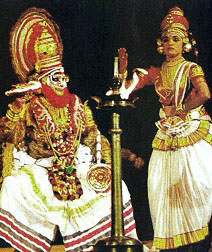Koodiyattom

Koodiyattom, one of Kerala's ancient theatre art form, was recently recognised by the United Nations Educational, Scientific and Cultural Organisation (UNESCO) as "a masterpiece of intangible cultural heritage.
Koodiyattom is the only surviving form of the Sanskrit theatre in the world. Literally meaning ’combined dancing’, a community of actors called Chakyars traditionally performs this art form and their female counterparts are called Nangiars. Today this art form is gaining popularity. The performance of Koodiyattom is codified through the Attaprakarams and Kramadeepikas, which contain the logistic, organizational and theatrical aspects of Koodiyattom. Koodiyattom until recently was performed only in temple complexes. Today it is more accessible to the world. The Kerala Kalamandalam started teaching this art form and admitted students from outside the Chakyar community. The plays are often from Sanskrit, which have minimal text.
Actors in Koodiyattom have the liberty to improvise upon an idea or a situation. In fact the focus of a Koodiyattom play is to enlarge a movement, an idea and an emotion by exploring the full potential of the situation. And a Sanskrit play with multiple layers of meaning, figures of speech, oblique or obscure expression and implied meaning is explored to the maximum. Netrabhinaya or expressing emotions through the eyes is important in Koodiyattom. The face is the main field of action with its delicately wrought eye, cheek, brow, and lip movement. Body and hand movements are highly codified. Perhaps one of the longest performances in the history of world theatre was a Koodiyattom play depicting the story of Ramayana, which took one whole year to complete.
More information on Koodiyattom can be found on http://en.wikipedia.org/wiki/Koodiyattom
Koodiyattom is the only surviving form of the Sanskrit theatre in the world. Literally meaning ’combined dancing’, a community of actors called Chakyars traditionally performs this art form and their female counterparts are called Nangiars. Today this art form is gaining popularity. The performance of Koodiyattom is codified through the Attaprakarams and Kramadeepikas, which contain the logistic, organizational and theatrical aspects of Koodiyattom. Koodiyattom until recently was performed only in temple complexes. Today it is more accessible to the world. The Kerala Kalamandalam started teaching this art form and admitted students from outside the Chakyar community. The plays are often from Sanskrit, which have minimal text.
Actors in Koodiyattom have the liberty to improvise upon an idea or a situation. In fact the focus of a Koodiyattom play is to enlarge a movement, an idea and an emotion by exploring the full potential of the situation. And a Sanskrit play with multiple layers of meaning, figures of speech, oblique or obscure expression and implied meaning is explored to the maximum. Netrabhinaya or expressing emotions through the eyes is important in Koodiyattom. The face is the main field of action with its delicately wrought eye, cheek, brow, and lip movement. Body and hand movements are highly codified. Perhaps one of the longest performances in the history of world theatre was a Koodiyattom play depicting the story of Ramayana, which took one whole year to complete.
More information on Koodiyattom can be found on http://en.wikipedia.org/wiki/Koodiyattom
